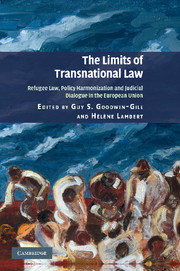 The Limits of Transnational Law
The Limits of Transnational Law Book contents
- Frontmatter
- Contents
- Notes on contributors and editors
- Acknowledgements
- Abbreviations
- 1 Transnational law, judges and refugees in the European Union
- 2 Where is the reference? On the limited role of transnational dialogue in Belgian refugee law
- 3 Transnational refugee law in the French courts: deliberate or compelled change in judicial attitudes?
- 4 The use of foreign asylum jurisprudence in the German administrative courts
- 5 The solipsistic legal monologue of Italian authorities
- 6 ‘Thou shalt not judge’ … Spanish judicial decision-making in asylum and the role of judges in interpreting the law
- 7 The British judiciary and the search for reciprocal relations with its continental partners
- 8 Speaking across borders: the limits and potential transnational dialogue on refugee law in Ireland
- 9 The absence of foreign law in Danish asylum decisions – quasi-judicial monologue with domestic policy focus?
- 10 Foreign law in Swedish judicial decision-making: playing a limited role in refugee law cases
- 11 The search for the one, true meaning …
- Bibliography
- Index
10 - Foreign law in Swedish judicial decision-making: playing a limited role in refugee law cases
Published online by Cambridge University Press: 06 July 2010
- Frontmatter
- Contents
- Notes on contributors and editors
- Acknowledgements
- Abbreviations
- 1 Transnational law, judges and refugees in the European Union
- 2 Where is the reference? On the limited role of transnational dialogue in Belgian refugee law
- 3 Transnational refugee law in the French courts: deliberate or compelled change in judicial attitudes?
- 4 The use of foreign asylum jurisprudence in the German administrative courts
- 5 The solipsistic legal monologue of Italian authorities
- 6 ‘Thou shalt not judge’ … Spanish judicial decision-making in asylum and the role of judges in interpreting the law
- 7 The British judiciary and the search for reciprocal relations with its continental partners
- 8 Speaking across borders: the limits and potential transnational dialogue on refugee law in Ireland
- 9 The absence of foreign law in Danish asylum decisions – quasi-judicial monologue with domestic policy focus?
- 10 Foreign law in Swedish judicial decision-making: playing a limited role in refugee law cases
- 11 The search for the one, true meaning …
- Bibliography
- Index
Summary
Introduction
Sweden has traditionally been, and has also considered itself to be, a country with a generous and humane policy on asylum and migration. The asylum system and the politics of asylum and migration are often debated, not least because of the large number of Iraqi asylum seekers that have arrived in Sweden in the past few years.
The asylum procedure was the subject of a major reform in 2005. The 2005 reform introduced a new system in which the appeals procedure was to be handled in the administrative court system by special Migration Courts and a Migration Court of Appeal. The first instance is the Migration Board. Important aims of the reform were to improve the opportunities to hold oral proceedings, to transform the asylum procedure into a ‘two-party process’ (similar but not identical to an adversarial process) and to enhance transparency. By taking these measures, it was hoped that the often-criticized asylum system would gain credibility among those involved in it, as well as among the general public. In the previous system, decisions at first instance were made by the Migration Board and, on appeal, by the Aliens Appeals Board, both of which were administrative authorities. The decision-makers at the Aliens Appeals Board, however, were judges specially appointed to adjudicate in refugee law cases. In certain circumstances either of the two authorities could refer cases to the government for the final decision.
- Type
- Chapter
- Information
- The Limits of Transnational LawRefugee Law, Policy Harmonization and Judicial Dialogue in the European Union, pp. 186 - 203Publisher: Cambridge University PressPrint publication year: 2010


